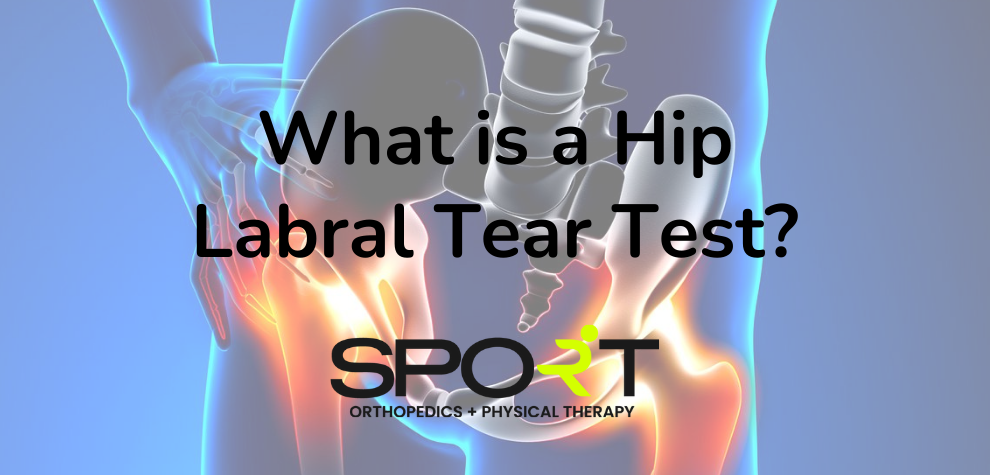Unfortunately, about 1 in 4 American adults suffer from chronic joint pain related to arthritis every year. That breaks down to about 15 million people suffering from joint pain. Some of this national joint pain can be boiled down to undiagnosed hip labral tears, depending on specific patient history of course. In fact, many hip labral tears can take over two years to diagnose because other hip conditions create similar symptoms. Fortunately, patients can undergo a specific hip labral tear test that can potentially shorten this average diagnosis window.
If you’re suffering from any kind of joint pain, doctors at SPORT Orthopedics + Physical Therapy want to help. Call us today at 469-200-2832 to make an appointment.
What is a Hip Labral Tear?
The hip, like any joint in the body, has a cushion of cartilage called the labrum. This cartilage keeps the ball of the thigh bone in place, connected to the pelvis, while preventing friction in the hip joint.
Basically, a hip labral tear is when this cartilage tears due to some kind of accident or overexertion. If hip labral tears go untreated, they can raise a patient’s chances of developing osteoarthritis.
Causes of Hip Labral Tears
The most common causes of hip labral tears are:
- Trauma: Sports such as football, soccer, hockey, and more can cause significant hip injuries if the athletes happen to twist or land wrong. Additionally, falls and car accidents are common causes of hip labral tears.
- Structural abnormalities: A condition called femoroacetabular impingement (FAI) can not only cause hip labral tears, but cause lifelong groin pain as well. FAI happens when the ball of the thigh bone doesn’t fit correctly into the hip socket and causes joint friction as a result. Other structural abnormalities that can lead to hip labral tears are hip dysplasia and Legg-Calvé-Perthes disease.
- Repetitive motions: Any kind of repetitive motions that someone may do as part of their job or during exercise can cause natural wear and tear on the joints. Without proper care, this can lead to any kind of joint issue including hip labral tears.
Symptoms of Hip Labral Tears
If you have a hip labral tear, you may experience some or all of these symptoms:
- Frequent hip or groin pain that worsens with standing, walking, running, or bending
- Clicking and popping sounds in the hip as you move
- General hip stiffness
- Inability to move your hip or leg as much as you should be able to
- Feeling unsteady while standing, walking, running, or bending
How to Diagnose a Hip Labral Tear
A doctor must rule out the potential that a patient’s symptoms are caused by another hip problem, such as a hip pointer, before diagnosing a hip labral tear. As stated previously, it can take more than two years to receive the correct diagnosis because many other hip disorders create similar symptoms. If you’re going to the doctor for hip pain, this is what you should expect.
Patient History
Firstly, a doctor will ask you about your medical history, mostly in relation to your hip pain. Do you suffer from hip pain at night? Your doctor will likely ask this question, as well as many others. You will need to provide:
- Details about your exact symptoms
- When your pain and symptoms started
- What hip movements cause pain
- Where you feel the pain most often
- Information about previous conditions, injuries, surgeries, and medications
Physical Exam
Your doctor will likely give you a physical exam to figure out how strong your hip joint is and how much it can move without pain. They will also look for any signs of bruising, redness, and swelling.
Diagnostic Testing
If a doctor suspects a hip labral tear, they may suggest various scans and injections in order to officially diagnose you.
- MRI: An MRI will provide a detailed picture of the soft tissues that make up the hip joint. However, an MRI occasionally won’t show a problem with the hip. If this is the case, then a doctor may resort to an MRI arthrogram, which is a scan that’s performed once a doctor injects a patient with contrast medium. This injection will provide a better set of pictures of a damaged hip joint.
- Other hip injections: If either of the MRI’s still aren’t showing a problem, then your doctor may resort to a numbing injection into the hip joint with the help of an ultrasound. If the patient’s pain goes away, then a doctor may assume that the hip labrum is likely the cause of pain.
- Arthroscopic hip surgery: If the previous options fail to provide any answers, then your doctor may suggest exploratory surgery. If you agree to this procedure, a surgeon will be able to get a good view of the hip joint by making a few tiny incisions. Then the surgeon will insert a tiny camera into these incisions in order to see whether you’re suffering from a hip labral tear or some other condition. If the surgeon spots a hip labral tear, then they will fix it during that surgery.
What is the FABER Test?
The least invasive hip labral tear test available is the FABER test, which stands for flexion, abduction, and external rotation. This test can often assist in diagnosing patients with a hip labral tear.
What’s the Purpose of the FABER Test?
The purpose of the hip labral tear test is to:
- Produce hip pain that a patient typically experiences
- Determine the hip’s range of motion
- Diagnose hip, spine, or sacroiliac joint conditions
- Determine what other tests are still needed
How is the FABER Test Performed?
If your doctor recommends that you undergo a hip labral tear test, they will ask you to lay on your back with your legs straight. Your doctor will then position the leg that’s on the same side as your hip pain into a figure four position. Basically, you will bend your knee and place your ankle over your opposite knee.
This position will look similar to “tree pose” in yoga. Then your doctor will gently push the bent knee down towards the exam table. If you experience hip or groin pain on the side of the bent leg that’s being pushed down, you may have a hip labral tear. Your doctor might order more tests before confirming your diagnosis.
Treatments for Hip Labral Tears
Depending on the severity of your hip labral tear, your doctor may suggest both non-surgical and surgical treatment options.
Non-Surgical Treatments
If you want to go the non-surgical route, your doctor may suggest rest, pain medications, injections, and physical therapy.
Rest
Excess movement will naturally cause more pain to someone suffering from a hip labral tear. In order to achieve maximum comfort, your doctor may tell you to rest as much as possible.
Pain Medications
Another way to control your hip pain is to take non-steroidal anti-inflammatory (NSAID) pain medications, like ibuprofen or aspirin. Of course, this is only a temporary solution while a patient undergoes other non-surgical treatments like injections and physical therapy.
Injections
If regular consumption of NSAIDS isn’t helping your hip pain, Dr. Burgos-Iturrino may suggest intra-articular injections or corticosteroid injections. The former is a local anesthetic and the latter is a steroid shot. Both of these injections can provide more relief than over-the-counter pain medications.
Physical Therapy
This non-surgical option is often a necessity for healing any kind of musculoskeletal issue. Dallas physical therapists at SPORT Orthopedics + Physical Therapy can assist your healing and pain levels by strengthening the hip joint and improving its range of motion and stability.
Surgical Treatments
If a variety of non-surgical options fail to improve your hip pain in 10 to 12 weeks, your doctor will likely suggest one of the surgeries listed below. There’s no need to fear though, because most hip surgeries are minimally invasive.
Arthroscopic Labral Debridement
In this procedure, your surgeon will trim and smooth the torn labrum through a few small incisions and a tiny camera called an arthroscope. You will only undergo this surgery if your doctor believes you suffer from a damaged or frayed labrum rather than a torn labrum.
Arthroscopic Hip Labral Repair
A surgeon will likely perform a hip labral repair if you definitely have a torn labrum, not just a damaged one. In this procedure, your surgeon may stitch the labrum back together or completely remove the torn section of the labrum.
Arthroscopic Hip Labral Replacement
If the hip labrum is simply damaged beyond repair, your surgeon may recommend replacing the tissue altogether. In order to do this, a surgeon will borrow tissue from another part of your body (or from a donor) to use as a new hip labrum. This is known as a hip labral replacement.
Call SPORT Orthopedics + Physical Therapy Today
At SPORT Orthopedics + Physical Therapy, we serve the Dallas and Frisco areas with extensive experience under our belts. Whether you need surgery or physical therapy, we’ve got you covered. For more information, or to schedule an appointment with a Dallas orthopedic doctor, please call our office at 469-200-2832 or fill out our online intake form today.



